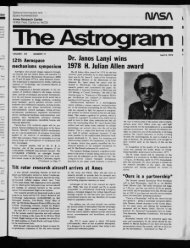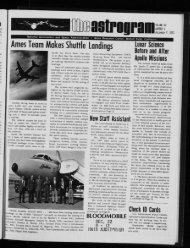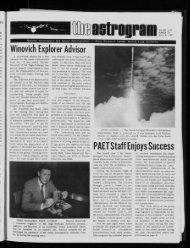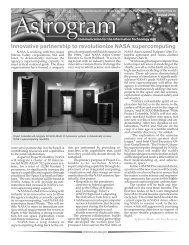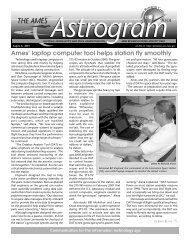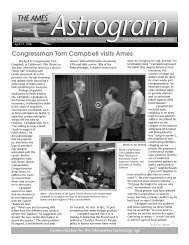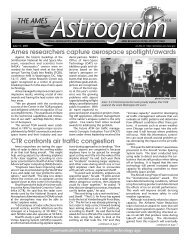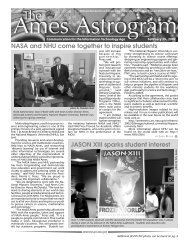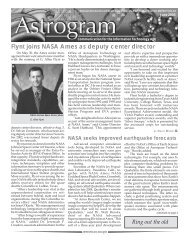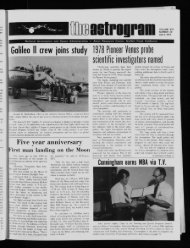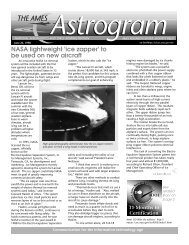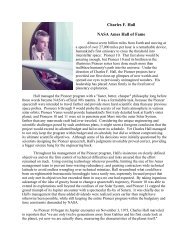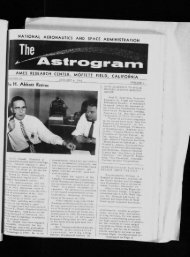1976 July-September - NASA Ames History Office
1976 July-September - NASA Ames History Office
1976 July-September - NASA Ames History Office
You also want an ePaper? Increase the reach of your titles
YUMPU automatically turns print PDFs into web optimized ePapers that Google loves.
National Aeronautics and<br />
Space Ad rpm-ustratior7<br />
<strong>Ames</strong> Research Center<br />
Moffetl F~eld. Cniiforl~ia 94035<br />
VOLUME XVII~ NUMBER 25 August 26, <strong>1976</strong><br />
<strong>NASA</strong> studying lighter.than.air vehicles<br />
Today’s concern lor the t-nvirollment arid for<br />
¢llergy conservation has generated i~cw interest in a<br />
means of flight ’,alder than the airplane.<br />
Airships were once an cstabhshed e~ement m<br />
world-wide transportation, providing the only mean~<br />
of non-stop rapid travel acros~ the world’s oceans<br />
LateL during and after World War 11. the? were the<br />
bulwark oi thb, harlem’s antisubmarine defenses The<br />
oM}’ current role Ior the airship, at least m thi~<br />
country, is advertising<br />
However, new requirement> for transporting<br />
heavy Loads m power plant COllStruCl}Oll. Irons<br />
Lerring ship c:~;go~ to ~hore points, and providing<br />
economical, quiet and energ~ con:,t’r, at~ve inler-cfly<br />
transportation are revi~ing interest in lighter-than-air<br />
vehicles MiIilary pkmners. Ioo. arc taking another<br />
look at the use el airships forxom0 ntilitar3 missions<br />
!OI W~lLch they Seell] to aL’*e particularl?, well adapted<br />
These new cLvil and inititat 3 applications will<br />
r~qmre ~chacie concept~, which do noI roe, creMe the<br />
mrships o~ the pagl Instead the} ma~, combine I e~e<br />
,.ncnts ot both hea~wr-than-air ~ellicles lairplane~,l<br />
~md lighter-than-air vehicles lairsbipsl<br />
Anle". I> currenll> -,tud)ing two hghter-than-air<br />
,con~.cp{~ for ~lVil ’dsc l:hr¢~Llgh a ~oiHrac~ v,i~lq<br />
(;£)od}CdT AcroSp;~CC Corp, Akroll ()hi{3<br />
]’he llrst ~H these concepts is heine studied l~r ill,<br />
pott’n~ia] as part el a ~Llttlre short-hau~ lrall,,portatl~m<br />
s}’Menl The. vehicle would he ai’,cd a~, :~<br />
{coder airliner and *.SOLIILt bc I~O 111 (2{)0 ~1 long and<br />
~arr~ 8({ passengers ,~]thougb this is aboul the su’e<br />
~ a (;ot~dvear bbml~. Its carrying capacil?, ~s lhree<br />
im}es u~ great<br />
It ’aould cruise at II,C’ krmts ~ 17n rllph } and be<br />
:d~e to land alld take oft verticaII}’ Power woukl be<br />
l~m~ished b3 four turboprop engules driving large<br />
prop-rotors wh{ch ~ould be tilled upward tot<br />
lakeoff and landing<br />
l-hi-, concept is partwLalarl?, attractr, e toda;<br />
because el ItS polonium for reduction,of noise md<br />
~uel constlmpt~on<br />
The other concept ullder stt~dy i:~ for a vehicle 1o<br />
transport large, hear} payloads c,’,’e~ comparativel><br />
short distance:,. This concept, calk’d a heavy lifteL<br />
,onlhmes features of large dirigible.,, and helicopterlyre<br />
rotor systems to provide ~iftillg capacity far<br />
beyond that el either vehicle type alone Dingible<br />
lnaoyancy is usc,d to lift the ~ehiclc elllply weight.<br />
leaving the total ~i|ting capa~-ily of the rotorsyMem<br />
to lilt and supporl Hie payload Vehicaes capable of<br />
lilting payloads ~ f up to 225,000 kg 125() tons I have<br />
been considered.<br />
A smaller proolLolLconcept version oi a heavy<br />
litter capabD ot littmg 6"~.5(10 kg t75 lens} is nndel<br />
study This version would usc four helicopler rotor<br />
SYslenls supporled by a dirigible ]luLl of<br />
?5,000 cubic meters (2.5 hill[ion cubic teet}<br />
displacemenL<br />
(If the two vehicles, the heavy lit’for appear:, tbe<br />
most likely for immediate application, transporting<br />
heavy power generating equipment or olher outsize.<br />
heavy industrial eqtlipment, partictdarlv, when the<br />
destination is a remote area m)t ~-rved b} other<br />
heaw transportation systems.<br />
There are a~so several potential military missions<br />
for the heavy lifter Principal among these is for<br />
transporting ship cargos over the beach to shore<br />
points<br />
<strong>NASA</strong>. m con nmction with the Na’,~ *s also<br />
studying other military u~s k)r ccm~entional airships.<br />
The missions being considered are tho~ which<br />
use the great endurance capability of airships to<br />
advantage such as antisubmarine warlare and sea<br />
control<br />
Sttbst{tutmg inert helium gas 1or the ~olatile<br />
hydrogen k~sed m the German airships oI ’~ne 20s and<br />
3Os. and benefitting from our increa~’d engineering<br />
knowledge and bette~ m~derstandJng of weather<br />
phenomena, a modern airship v. ould be an<br />
extremel_v sale vehicle 1o fl~,<br />
[he N,kgA sponsored ~tud~es will be completed<br />
this summer It as anticipated that a number ol ne’a<br />
technologs approaches and thei~ benefits wil! be<br />
defined [here will also likeb be a number ofarea~<br />
needing research and de~ek)pment xqdch ~,iu he<br />
benci-~cia] to modern :2irsblp concept~, which could<br />
be pursued in the future<br />
<strong>NASA</strong>-ASi:E design study:<br />
Project Orion<br />
[.~er3 summer for the past eight },’ears <strong>Ames</strong><br />
Research (’enter and Stanford University have<br />
]ointl2. coordinated <strong>NASA</strong>-ASEt: design studies ona<br />
wide ~arieb ol logics This summer, the stud},, has<br />
considered the design of sastems which would<br />
enabk, mankind to address, a ~undamenlal and as yet<br />
uJ1an~.wered questJor~ "’Arc planetaD systems a<br />
common occun-ence m the Ga~axs. or is the soIar<br />
¯ ,}"sterrl unique’P’ The project director was David<br />
Bho, el <strong>Ames</strong> lheoretica] and PlanetaD Studies<br />
Branch<br />
Tbc etie~rls (li thh, st.lmn’ter were directed primaril}’<br />
~o,aard the de~.ign oi an ultimate telescope<br />
for tha. purpose c)l a>trorn,.’tric detection of p[anets.<br />
,~Mronl¢lr} IS [ha~ branch o~ astronomy concerned<br />
~ith prcci,.~- determination> of the position of stars.<br />
]f a star has a planetar5 companion, the apparent<br />
mellon o} the stay across the sk}’ will undergo a<br />
slnal~ bur m princilq~, detectable wobble. Some<br />
leehng tor the magnitude of the task can be had<br />
Ir(~m the Iollowing example Detection of the wobl,<br />
le m the Sun’:, mohon d~e to Jupiter. as %owed<br />
¢ (7¢m H~zu~’d !;~l Pa~¢ 4J<br />
Remotely Piloted Research Vehicle



